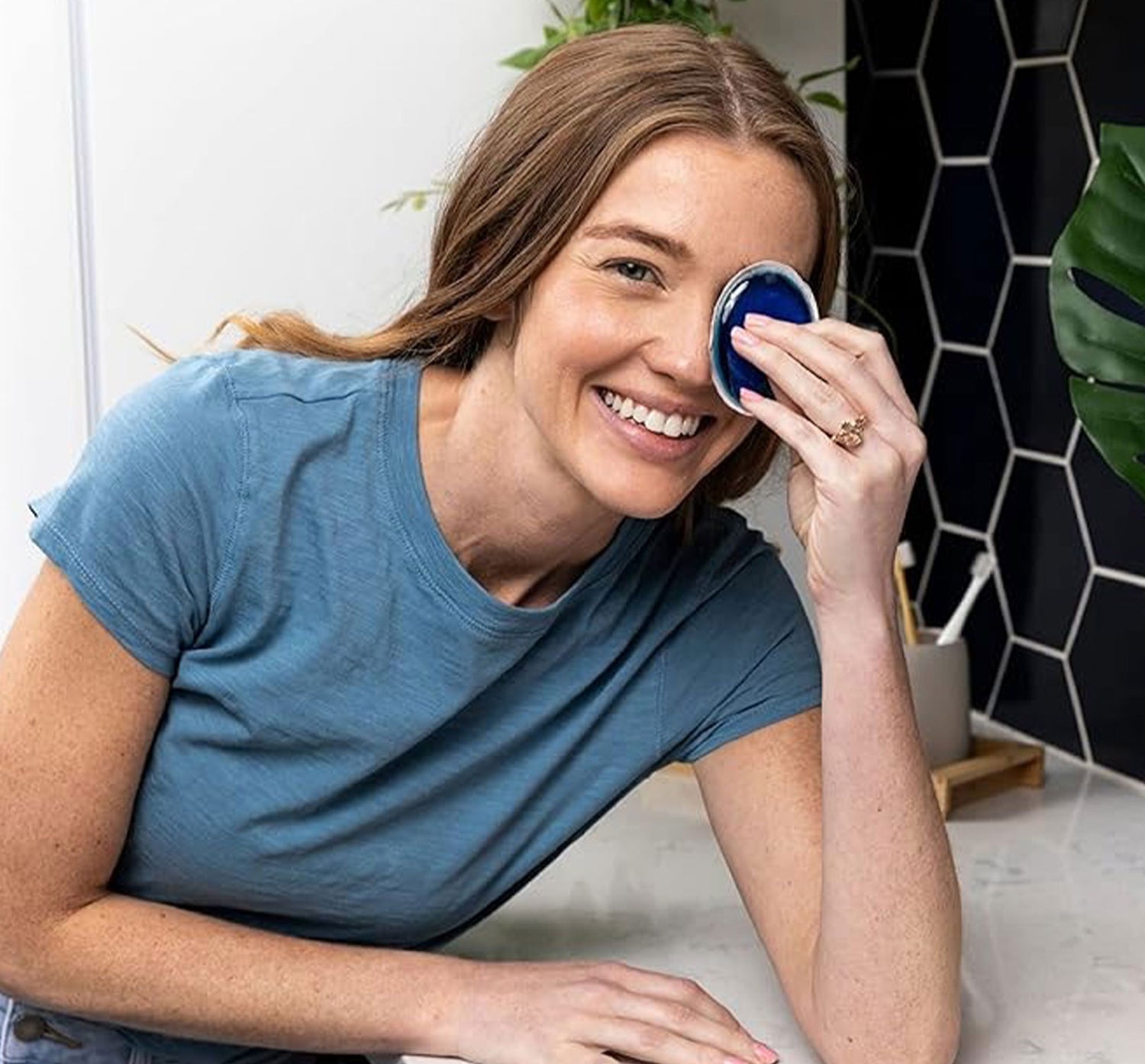General Eye Compress and Relief
Our eyes work hard every day, from staring at screens to exposure to harsh environmental elements. Over time, this strain can lead to discomfort, dryness, puffiness, or even headaches. Whether you're dealing with tired eyes, sinus pressure, or recovering from an eye procedure, eye compresses and relief patches can provide natural, effective comfort.
One of the most popular ways to soothe the eyes is through the use of Eye-press compresses and patches. They provide targeted relief using warmth or cooling effects, depending on your needs. But how do they work, and which type should you choose? Continue reading to learn the answers below.

What Are Eye Compresses?
An eye compress is a simple yet effective tool used to relieve eye strain, puffiness, dryness, and irritation. It typically consists of a soft fabric or gel-filled pack that can be heated or cooled to provide relief.
There are two main types of compresses:
- Warm Eye Compresses – Used for dry eye syndrome, meibomian gland dysfunction (MGD), sinus pressure, and styes.
- Cold Eye Compresses – Ideal for reducing puffiness, inflammation, headaches, and allergic reactions.
Eye compresses can be reusable or disposable, and some are designed for medical-grade therapy, while others are made for general relaxation and skincare purposes.
Why Use an Eye Compress?
People turn to eye compresses for many reasons, including:
Warm vs. Cold Eye Compresses: When to Use Each
Not sure whether to apply heat or cold to your eyes? Here’s a breakdown of when to use each:

Warm Compress: Best for Dry, Irritated, or Stressed Eyes
A warm eye compress works by improving circulation, relaxing muscles, and helping to unclog blocked glands. It’s particularly helpful for:
- Dry eye syndrome (DES) – Encourages better tear production by loosening blocked oil glands.
- Blepharitis – Helps with inflammation caused by bacterial buildup on the eyelids.
- Styes and chalazions – A warm compress softens the blockage and promotes natural drainage.
- Sinus pressure and headaches – Heat relaxes tense muscles and reduces congestion.
- Post-eye surgery recovery – Doctors often recommend warm compresses to aid healing.

Cold Compress: Best for Puffiness, Allergies, and Headaches
A cold compress constricts blood vessels, reduces inflammation, and numbs discomfort. It’s particularly useful for:
- Puffy eyes and under-eye bags – Cooling effects help drain excess fluid and reduce swelling.
- Dark circles – Encourages blood circulation to brighten tired eyes.
- Eye allergies and irritation – Reduces itching, burning, and redness caused by allergens.
- Migraine and sinus headaches – Helps soothe throbbing pain and tension.
- Post-surgery swelling – Doctors may recommend a cold compress to minimize post-op swelling.
How to Use Eye-Press Compresses and Patches Effectively
-
Using a Warm Eye Compress
- Choose Your Compress – Opt for a microwavable gel pad, warm washcloth, or a heated Eye-press compress designed for dry eyes.
- Heat Properly – If using a microwaveable compress, follow the heating instructions carefully (usually 10-15 seconds).
- Test the Temperature – Make sure it’s warm, not too hot, before placing it on your eyes.
- Apply for 10-15 Minutes – Lie back, relax, and allow the warmth to penetrate.
- Repeat as Needed – For chronic dry eyes or meibomian gland dysfunction, use 1-2 times daily.
-
Using a Cold Eye Compress
- Choose a Cooling Patch or Gel Mask – Some patches are designed to be stored in the fridge for quick relief.
- Chill for 10-15 Minutes – A compress or patch should be cool but not frozen.
- Apply for 10-15 Minutes – Gently place over closed eyelids and relax.
- Use as Needed – Great for morning puffiness, post-exercise relief, or after a long workday.
The Science Behind Eye-Press Compresses and Patches
Unlike basic compresses, Eye-press compresses and patches are designed with ergonomic contours to fit comfortably over the eyes. Some models feature:
- Consistent temperature regulation to maintain warmth or cold for longer periods.
- Adjustable straps for a secure, hands-free fit.
- Weighted designs for gentle acupressure effects, helping relax facial tension.
- Moist heat technology that enhances hydration for dry eyes.
These specialized features make them ideal for both everyday eye relief and medical use.
FAQs About Eye Compresses and Relief Patches
Eye compresses and relief patches are widely used for addressing common eye issues such as dryness, puffiness, headaches, and sinus pressure. They also play a key role in stye treatment, with warm compresses being a go-to remedy for reducing inflammation and encouraging healing.
Whether you're using heat to ease irritation or a cold patch to calm swelling, using these tools correctly can improve comfort and speed up recovery.
Below are answers to the most frequently asked questions about eye compresses and relief patches—designed to help you get the best results from your daily eye care routine.
FAQs
How Do Eye Compresses Work?
Eye compresses work by applying gentle heat or cooling to the eyes, which helps improve circulation, reduce inflammation, and soothe discomfort.
- Warm compresses open up blocked glands, loosen debris on the eyelids, and relax eye muscles.
- Cold compresses constrict blood vessels, reduce puffiness, and calm irritation.
Depending on your condition, you may need to choose between heat therapy or cold therapy for the best results.
How Often Should I Use an Eye Compress?
This depends on your specific eye concern:
- For dry eyes or blepharitis: Use a warm compress twice daily for 10–15 minutes.
- For sinus pressure or headaches: Apply a warm or cold compress as needed throughout the day.
- For puffy eyes or dark circles: Use a cold compress in the morning or after prolonged screen time.
- For general eye strain: A warm compress once a day can provide relaxation and relief.
If your symptoms persist or worsen, consult an eye care professional.
Can I Use Both Warm and Cold Compresses?
Yes! Many people combine both treatments depending on their symptoms.
- Use a warm compress first to relax the eye muscles, improve circulation, and loosen oil blockages.
- Follow up with a cold compress to reduce swelling, puffiness, or redness.
This dual approach is particularly effective after long screen hours or during allergy season.
How Long Should I Keep an Eye Compress On?
Most eye compresses should be applied for 10–15 minutes at a time.
- Warm compresses should be comfortably warm but not too hot to prevent burns.
- Cold compresses should be cool but not frozen to avoid excessive numbing.
If using a reusable gel-based compress, follow the manufacturer’s instructions for safe application.
Can Eye Compresses Help with Dark Circles?
Yes! Cold compresses and cooling eye patches can reduce inflammation and increase circulation, which may help minimize dark circles and under-eye bags.
For best results:
- Use a chilled gel eye mask or cooling patch for 10 minutes in the morning.
- Stay hydrated and get adequate sleep to prevent worsening dark circles.
- Apply a moisturizing eye cream after using the compress to keep skin hydrated.
While cold therapy can help brighten the under-eye area, genetics and lifestyle factors also play a role in dark circles.
Are Eye Compresses Safe for Sensitive Skin?
Most high-quality eye compresses and relief patches are made with hypoallergenic, soft materials that are gentle on the skin.
However, if you have highly sensitive skin:
- Check the ingredients if using gel-based cooling patches to avoid potential allergens.
- Use fragrance-free, dermatologist-tested products.
- Avoid compresses that get too hot or too cold, as extreme temperatures can cause irritation.
If you experience redness, itching, or discomfort, discontinue use and consult a dermatologist.
Can I Use an Eye Compress While Wearing Contact Lenses?
No, it’s best to remove contact lenses before using an eye compress.
- A warm compress may cause your lenses to dry out or shift.
- A cold compress may create uneven cooling, making lenses uncomfortable.
For maximum comfort, remove contacts before applying a compress, and wait at least 10–15 minutes before putting them back in.
How Do I Clean and Maintain My Eye Compress?
To keep your eye compress clean and hygienic:
- Fabric-based compresses: Wash with mild soap and warm water, then air dry.
- Gel-based compresses: Wipe with a damp cloth and mild soap after each use.
- Disposable patches: Follow manufacturer instructions for single-use application.
Regular cleaning prevents bacteria buildup and ensures safe, long-term use.
Can Eye Compresses Help with Eye Fatigue from Screens?
Absolutely! If you spend hours looking at screens, an eye compress can reduce strain and refresh your eyes.
- A warm compress relaxes eye muscles and improves moisture.
- A cold compress soothes tired eyes and reduces redness.
Try using a compress after long workdays or before bed to prevent digital eye strain symptoms.
Are There Any Side Effects to Using Eye Compresses?
Eye compresses are generally safe when used correctly, but a few precautions apply:
- Overheating a warm compress can cause burns or irritation.
- Using a cold compress for too long may lead to numbness or frostbite-like symptoms.
- Not cleaning reusable compresses can lead to bacterial infections.
Always test the temperature before applying, and follow manufacturer guidelines to avoid complications.
Can Eye Compresses Help After Eye Surgery?
Yes, many eye doctors recommend eye compresses after procedures like LASIK, cataract surgery, or blepharoplasty.
- Cold compresses help reduce swelling and discomfort post-surgery.
- Warm compresses aid in healing and moisture retention.
However, always follow your doctor's specific recommendations regarding post-surgery eye care.
Can I Sleep with an Eye Compress On?
It’s generally not recommended to sleep with a heated or cooling compress, as prolonged exposure could cause skin irritation or discomfort.
Instead, opt for:
- Weighted sleep masks for gentle relaxation.
- Hydrating overnight eye patches that provide continuous moisture.
If using a compress for relaxation before bed, remove it after 10–15 minutes for safe use.
Can an Eye Compress Be Used for Stye Treatment?
Yes, an eye compress—especially a warm compress—is one of the most effective and widely recommended stye treatments. Applying gentle heat helps to:
Soften the blocked oil gland causing the stye
Encourage drainage of pus or fluid
Reduce pain, swelling, and redness
Speed up the natural healing process
For best results, use a clean, warm compress on the affected eye for 10–15 minutes, 3–4 times a day, until the stye drains and heals. Always wash your hands before and after treatment to prevent infection from spreading.
Are There Any Natural Alternatives to Eye Compresses?
Yes! If you don’t have a store-bought compress, you can try:
- A warm washcloth – Run a cloth under warm water, wring it out, and place it over your eyes.
- Chilled cucumber slices – Help soothe puffiness and irritation.
- Cold tea bags – Green or chamomile tea bags can help with swelling and inflammation.
While these methods can provide temporary relief, eye compresses and patches offer more consistent temperature control and effectiveness.
